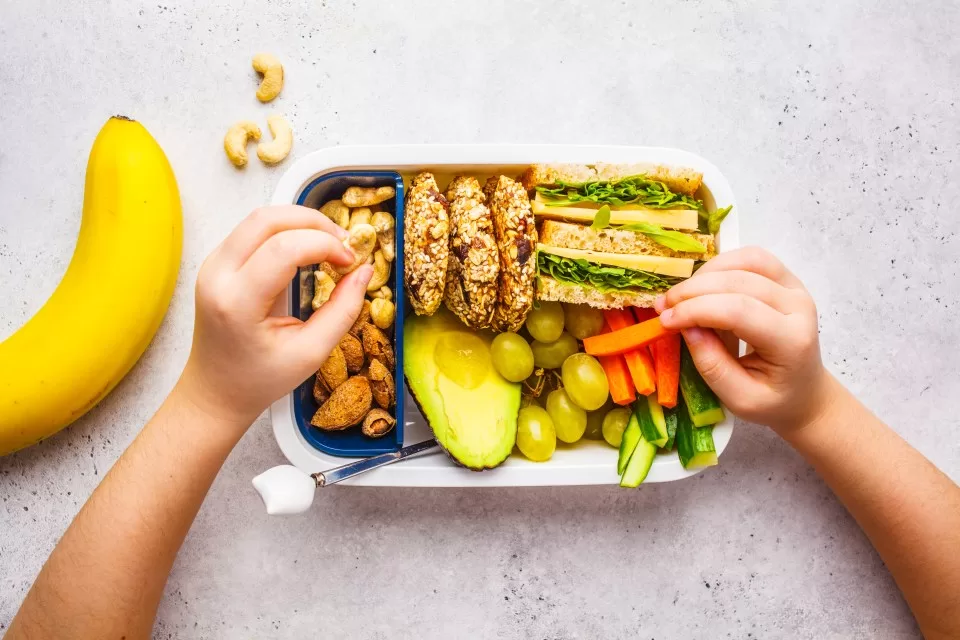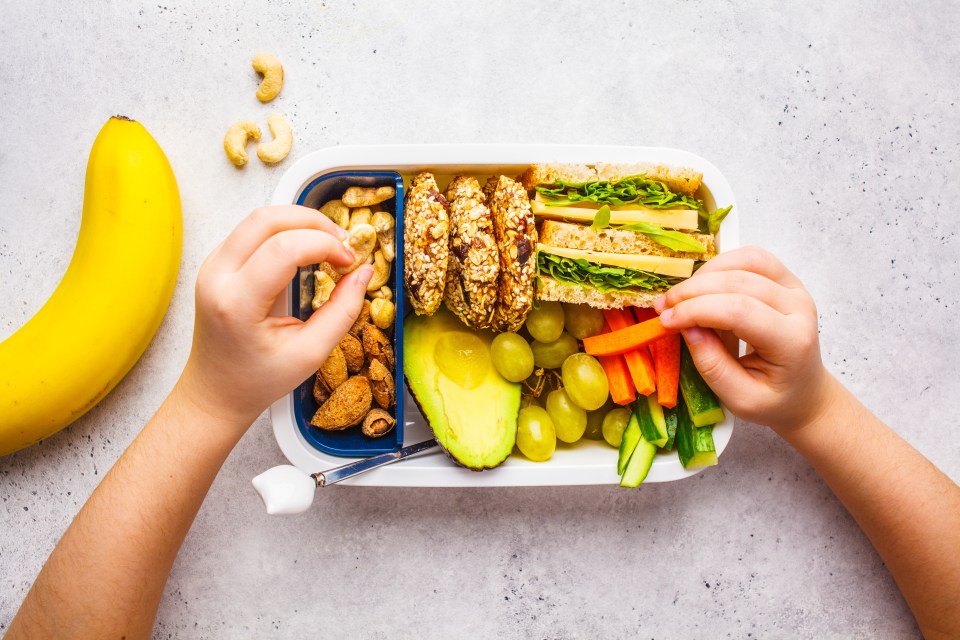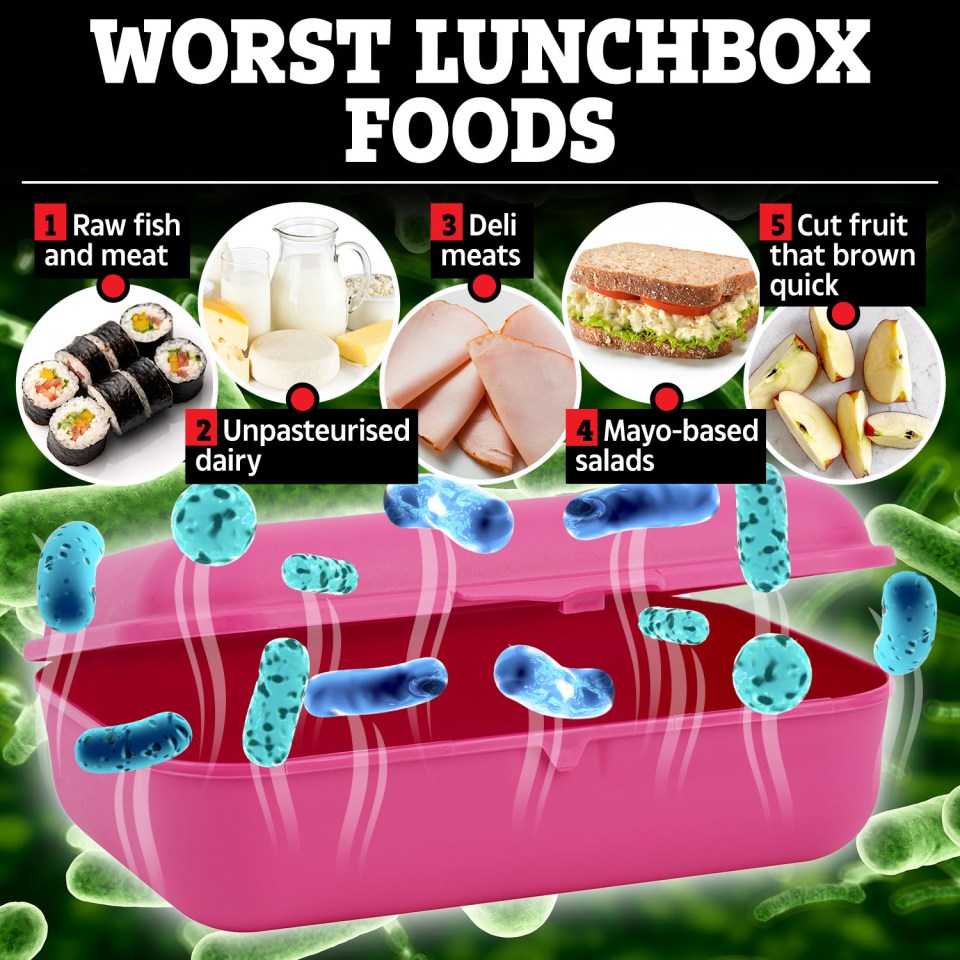THE start of a new school year heralds the slog planning daily snacks and lunches for many parents.
Whether you’re slapping a sandwich together last thing before the school run or meticulously planning it the evening before, preparing your child’s lunchbox can seem like just another thing on the list.
And it can be tricky to strike the balance between foods that are nutritious and tasty enough to satisfy picky tots.
But experts warn that certain foods can be major sources of bacteria when thrown in your kid’s lunchbox.
From your go-to sandwich filling to the chopped up fruit for your child’s five-a -day, there’s a risk of bacteria multiplying on these foods when they sit in at the bottom of your tot’s bag for too long.
According to food safety expert Sylvia Anderson, five kinds of bacteria may thrive in some lunchbox staples if they’re left at room temperature for too long: E. coli, Salmonella, Listeria, Campylobacter and Bacillus cereus.
“As the school year rolls around, preparing nutritious and safe lunchboxes for children is a top priority for parents,” the food safety consultant told The Sun.
“But while packing healthy meals is important, it’s equally essential to ensure that the food stays safe to eat until lunchtime.
“Children are more susceptible to food-borne illnesses because of their developing immune systems, so understanding which foods are prone to spoiling and how to store them properly can help reduce the risk of food poisoning.
“Here are some foods parents should avoid putting in children’s lunchboxes and why.”
1. Unpasteurised dairy products
It’s worth paying attention to whether dairy products you have in the house are pasteurised before putting them in your kid’s lunchbox.
Sylvia warned: “Raw or unpasteurised dairy products, such as some cheeses or milk, can carry harmful bacteria like Listeria and Campylobacter.
“These pathogens pose a serious risk to young children, especially if the food is not stored properly.”
Eating listeria-contaminated foods can lead to listeriosis, a rare but nasty infection that causes fever, vomiting and diarrhoea and may make some people seriously ill.
Meanwhile, Campylobacter bacteria could make your little one ill with diarrhoea.
“Always choose pasteurised dairy products,” Sylvia recommended.
“Cheese sticks, yogurt, and milk from pasteurised sources are safer and easily portable.”
2. Uncooked meats and fish
Sylvia advised against grabbing sushi from the supermarket as a lunchbox treat.
“Raw meats and fish can harbour dangerous bacteria like E. coli, Salmonella, and Listeria,” she explained.
“These bacteria multiply quickly at room temperature, especially if lunch is not refrigerated for several hours.”
Salmonella is a common source of food poisoning and infections can leave people diarrhoea, fever and stomach pains.
“If your child enjoys fish, opt for pre-cooked fish, canned tuna, or fully cooked meats,” Sylvia suggested.
3. Deli meats
“While deli meats like ham, turkey, and salami are popular lunchbox items, they can be contaminated with Listeria if not handled or stored correctly,” Sylvia said.
“The bacteria thrive at room temperatures, making these meats unsafe if left unrefrigerated for too long.”
If your tot is partial to ham sandwiches, there are ways to can make it safer for them to consume at school.
“If you choose to pack deli meats, make sure they are kept cold with an ice pack or an insulated lunchbox,” Sylvia suggested.
“Otherwise, cooked chicken strips or homemade meatballs can be healthier and safer substitutes.”
4. Mayonnaise-based salads
Egg-mayo or tuna salad can be a go-to filling for sandwiches.
But Sylvia advised caution in giving them to your children for school lunches.
She explained: “Mayonnaise-based salads can spoil quickly if not kept cold.
“When mixed with protein-rich ingredients like eggs, tuna, or chicken, the risk of bacterial growth increases significantly, making it a dangerous option for lunchboxes.
“If you love packing these salads, consider adding an ice pack or freezing the sandwich overnight.
“Hummus or nut butters can be safer alternatives that are also rich in protein.”
5. Cut fruit that brown easily
Adding an apple or pear into your kid’s lunchbox is an easy way to help them reach their five-a-day.
But cutting them up can make it easier for bacteria to thrive on them if they’re not kept cold.
Sylvia explained: “Cut fruits like apples and pears brown quickly when exposed to air, which isn’t a health hazard but may make them unappealing to eat.
Safe lunchbox foods
Instead of packing items that could spoil easily, here are some healthy, safe alternatives for your child’s lunchbox:
- Whole fruits (apples, oranges, bananas)
- Vegetable sticks (carrots, celery) paired with hummus
- Nut butter sandwiches (if your child’s school allows nuts)
- Pre-packaged applesauce or fruit cups
- Granola bars or trail mix
- Pre-cooked grains like quinoa or couscous mixed with vegetables
- Crackers with cheese (kept cool with an ice pack)
“However, if these fruits are not kept cool, bacteria can also grow on them.”
The food safety expert suggested a couple hacks for when you’re packing fruit for your kid’s school lunch.
“If you want to pack cut fruits, dip them in lemon juice to prevent browning, or choose whole fruits like bananas, grapes, or oranges, which can last longer without refrigeration,” she said.
FOODS THAT SPOIL QUICKLY
Sylvia also listed foods items that are particularly prone to bacterial growth and spoilage if not stored correctly.
1. Dairy products
The food safety expert said that dairy products like milk, yoghurt and cheese “need to be kept cold, ideally below 5°C”.
She explained: “When left out for more than four hours, bacteria like Salmonella and E. coli can grow, increasing the risk of food-borne illness.”
To combat this, she suggested you use insulated lunchboxes and include ice packs to keep yogurt and cheese at safe temperatures.
2. Cooked meats
“Chicken, beef, and other cooked meats are prone to bacterial contamination, particularly if they stay in the “danger zone” between 5°C – 63°C for extended periods,” Sylvia went on.
The food safety expert shared a tip make consuming them safer.
“Freeze cooked meat items overnight so they stay cold longer or pack them with an ice pack.”
3. Eggs
“Hard-boiled eggs, although cooked, can also be risky if left out for too long,” Sylvia added.
“Bacteria like Salmonella can grow on eggs if they aren’t kept at a safe temperature.”
“Keep hard-boiled eggs cold,” she advised.
Or you could go for other protein-rich foods instead, like pre-packaged hummus or nut butter.
4. Rice and pasta
Giving your tot leftover rice and pasta for their packed lunch might seem like a quick way to solve the lunchbox conundrum.
But Sylvia said: “Cooked rice and pasta are surprisingly prone to bacterial growth, especially Bacillus cereus, a bacterium that thrives in cooked starchy foods.”
Bacillus cereus is yet another germ that can cause food poisoning and unpleasant digestive symptoms – like stomach pain and watery diarrhoea.
“Store cooked rice or pasta dishes in an insulated container and keep them cold until it’s time to eat,” Sylvia advised.
LUNCHBOX SAFETY TIPS
The food safety expert shared some handy tips to reduce the risk of food-borne illness and keep your child’s lunch safe.
1. Use insulated lunchboxes and ice packs
“A well-insulated lunchbox with a couple of ice packs can help keep food at a safe temperature for several hours,” Sylvia said.
“Place perishable items directly next to the ice packs.”
2. Freeze foods the night before
“Freezing items like sandwiches, juice boxes, or yogurt tubes can help them stay cool until lunchtime,” according to the food safety expert.
3. Keep hand sanitiser handy
Making sure children wash their hands before eating can be a task, but it’s important for reducing the risk of getting sick from food.
“If handwashing isn’t possible, include hand sanitising wipes or gel in their lunchbox to reduce the risk of transferring bacteria from hands to food,” Sylvia advised.
4. Opt for shelf-stable items
“Certain foods don’t require refrigeration and are great for lunchboxes,” Sylvia added.
“These include whole fruits, crackers, nuts, dried fruits, and nut butters.
“Pre-packaged options like trail mix or granola bars are also safe and nutritious.”
Do I have food poisoning?
Food poisoning is rarely serious and usually gets better within a week.
It’s hard to miss the symptoms, which include:
- Feeling sick (nausea)
- Diarrhoea
- Being sick (vomiting)
- Stomach cramps
- A high temperature of 38C or above
- Feeling generally unwell – such as feeling tired or having aches and chills
- The symptoms usually start within a few days of eating the food that caused the infection.
- Sometimes they start after a few hours or not for a few weeks
How to treat food poisoning
You can usually treat yourself or your child at home.
The symptoms usually pass within a week.
The most important thing is to have lots of fluids, such as water or squash, to avoid dehydration.
You should also see a doctor if along with other symptoms you have high fever, blood in your stool, or feel dehydrated or unable to keep any food or liquid down.
Make sure you stay off school or work until you have not been sick or had diarrhoea for at least 2 days.
Source: NHS


